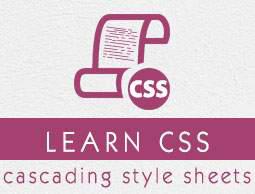CSS - Backgrounds
This chapter teaches you how to set backgrounds of various HTML elements. You can set the following background properties of an element −
The background-color property is used to set the background color of an element.
The background-image property is used to set the background image of an element.
The background-repeat property is used to control the repetition of an image in the background.
The background-position property is used to control the position of an image in the background.
The background-attachment property is used to control the scrolling of an image in the background.
The background property is used as a shorthand to specify a number of other background properties.
Set the Background Color
Following is the example which demonstrates how to set the background color for an element.
<html>
<head>
</head>
<body>
<p style = "background-color:yellow;">
This text has a yellow background color.
</p>
</body>
</html>
This will produce following result −
Set the Background Image
We can set the background image by calling local stored images as shown below −
<html>
<head>
<style>
body {
background-image: url("/css/images/css.jpg");
background-color: #cccccc;
}
</style>
</head>
<body>
<h1>Hello World!</h1>
</body>
<html>
It will produce the following result −
Repeat the Background Image
The following example demonstrates how to repeat the background image if an image is small. You can use no-repeat value for background-repeat property if you don't want to repeat an image, in this case image will display only once.
By default background-repeat property will have repeat value.
<html>
<head>
<style>
body {
background-image: url("/css/images/css.jpg");
background-repeat: repeat;
}
</style>
</head>
<body>
<p>Tutorials point</p>
</body>
</html>
It will produce the following result −
The following example which demonstrates how to repeat the background image vertically.
<html>
<head>
<style>
body {
background-image: url("/css/images/css.jpg");
background-repeat: repeat-y;
}
</style>
</head>
<body>
<p>Tutorials point</p>
</body>
</html>
It will produce the following result −
The following example demonstrates how to repeat the background image horizontally.
<html>
<head>
<style>
body {
background-image: url("/css/images/css.jpg");
background-repeat: repeat-x;
}
</style>
</head>
<body>
<p>Tutorials point</p>
</body>
</html>
It will produce the following result −
Set the Background Image Position
The following example demonstrates how to set the background image position 100 pixels away from the left side.
<html>
<head>
<style>
body {
background-image: url("/css/images/css.jpg");
background-position:100px;
}
</style>
</head>
<body>
<p>Tutorials point</p>
</body>
</html>
It will produce the following result −
The following example demonstrates how to set the background image position 100 pixels away from the left side and 200 pixels down from the top.
<html>
<head>
<style>
body {
background-image: url("/css/images/css.jpg");
background-position:100px 200px;
}
</style>
</head>
<body>
<p>Tutorials point</p>
</body>
</html>
It will produce the following result −
Set the Background Attachment
Background attachment determines whether a background image is fixed or scrolls with the rest of the page.
The following example demonstrates how to set the fixed background image.
<!DOCTYPE html>
<html>
<head>
<style>
body {
background-image: url('/css/images/css.jpg');
background-repeat: no-repeat;
background-attachment: fixed;
}
</style>
</head>
<body>
<p>The background-image is fixed. Try to scroll down the page.</p>
<p>The background-image is fixed. Try to scroll down the page.</p>
<p>The background-image is fixed. Try to scroll down the page.</p>
<p>The background-image is fixed. Try to scroll down the page.</p>
<p>The background-image is fixed. Try to scroll down the page.</p>
<p>The background-image is fixed. Try to scroll down the page.</p>
<p>The background-image is fixed. Try to scroll down the page.</p>
<p>The background-image is fixed. Try to scroll down the page.</p>
<p>The background-image is fixed. Try to scroll down the page.</p>
</body>
</html>
It will produce the following result −
The following example demonstrates how to set the scrolling background image.
<!DOCTYPE html>
<html>
<head>
<style>
body {
background-image: url('/css/images/css.jpg');
background-repeat: no-repeat;
background-attachment: fixed;
background-attachment:scroll;
}
</style>
</head>
<body>
<p>The background-image is fixed. Try to scroll down the page.</p>
<p>The background-image is fixed. Try to scroll down the page.</p>
<p>The background-image is fixed. Try to scroll down the page.</p>
<p>The background-image is fixed. Try to scroll down the page.</p>
<p>The background-image is fixed. Try to scroll down the page.</p>
<p>The background-image is fixed. Try to scroll down the page.</p>
<p>The background-image is fixed. Try to scroll down the page.</p>
<p>The background-image is fixed. Try to scroll down the page.</p>
<p>The background-image is fixed. Try to scroll down the page.</p>
</body>
</html>
It will produce the following result −
Shorthand Property
You can use the background property to set all the background properties at once. For example −
<p style = "background:url(/images/pattern1.gif) repeat fixed;">
This parapgraph has fixed repeated background image.
</p>


